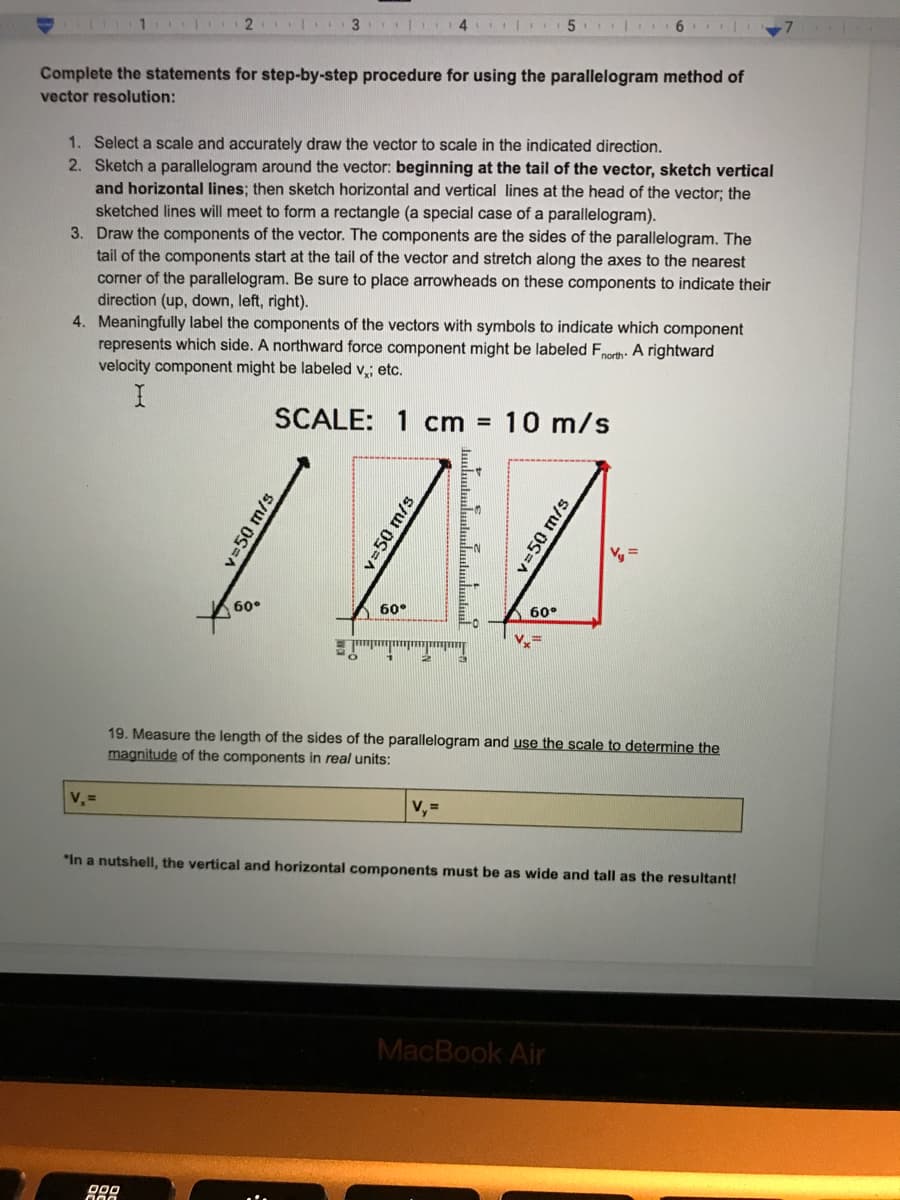19. Measure the length of the sides of the parallelogram and use the scale to determine the magnitude of the components in real units: V = v,= *In a nutshell, the vertical and horizontal components must be as wide and tall as the resultant!
19. Measure the length of the sides of the parallelogram and use the scale to determine the magnitude of the components in real units: V = v,= *In a nutshell, the vertical and horizontal components must be as wide and tall as the resultant!
Physics for Scientists and Engineers: Foundations and Connections
1st Edition
ISBN:9781133939146
Author:Katz, Debora M.
Publisher:Katz, Debora M.
Chapter3: Vectors
Section: Chapter Questions
Problem 65PQ
Related questions
Question
I need help with this question
(Not honor class)
(Not grading)

Transcribed Image Text:1
5. | 6
Complete the statements for step-by-step procedure for using the parallelogram method of
vector resolution:
1. Select a scale and accurately draw the vector to scale in the indicated direction.
2. Sketch a parallelogram around the vector: beginning at the tail of the vector, sketch vertical
and horizontal lines; then sketch horizontal and vertical lines at the head of the vector; the
sketched lines will meet to form a rectangle (a special case of a parallelogram).
3. Draw the components of the vector. The components are the sides of the parallelogram. The
tail of the components start at the tail of the vector and stretch along the axes to the nearest
corner of the parallelogram. Be sure to place arrowheads on these components to indicate their
direction (up, down, left, right).
4. Meaningfully label the components of the vectors with symbols to indicate which component
represents which side. A northward force component might be labeled Fnorth: A rightward
velocity component might be labeled v,; etc.
SCALE: 1 cm =
10 m/s
60°
60°
60°
19. Measure the length of the sides of the parallelogram and use the scale to determine the
magnitude of the components in real units:
V, =
V, =
*In a nutshell, the vertical and horizontal components must be as wide and tall as the resultant!
MacBook Air
v=50 m/s
v=50 m/s
v350 m/s
Expert Solution
This question has been solved!
Explore an expertly crafted, step-by-step solution for a thorough understanding of key concepts.
Step by step
Solved in 2 steps with 2 images

Knowledge Booster
Learn more about
Need a deep-dive on the concept behind this application? Look no further. Learn more about this topic, physics and related others by exploring similar questions and additional content below.Recommended textbooks for you

Physics for Scientists and Engineers: Foundations…
Physics
ISBN:
9781133939146
Author:
Katz, Debora M.
Publisher:
Cengage Learning

Physics for Scientists and Engineers, Technology …
Physics
ISBN:
9781305116399
Author:
Raymond A. Serway, John W. Jewett
Publisher:
Cengage Learning

College Physics
Physics
ISBN:
9781285737027
Author:
Raymond A. Serway, Chris Vuille
Publisher:
Cengage Learning

Physics for Scientists and Engineers: Foundations…
Physics
ISBN:
9781133939146
Author:
Katz, Debora M.
Publisher:
Cengage Learning

Physics for Scientists and Engineers, Technology …
Physics
ISBN:
9781305116399
Author:
Raymond A. Serway, John W. Jewett
Publisher:
Cengage Learning

College Physics
Physics
ISBN:
9781285737027
Author:
Raymond A. Serway, Chris Vuille
Publisher:
Cengage Learning

College Physics
Physics
ISBN:
9781938168000
Author:
Paul Peter Urone, Roger Hinrichs
Publisher:
OpenStax College

Physics for Scientists and Engineers
Physics
ISBN:
9781337553278
Author:
Raymond A. Serway, John W. Jewett
Publisher:
Cengage Learning

Physics for Scientists and Engineers with Modern …
Physics
ISBN:
9781337553292
Author:
Raymond A. Serway, John W. Jewett
Publisher:
Cengage Learning